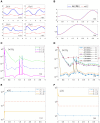An adaptive discretized RNN algorithm for posture collaboration motion control of constrained dual-arm robots
- PMID: 38840656
- PMCID: PMC11150663
- DOI: 10.3389/fnbot.2024.1406604
An adaptive discretized RNN algorithm for posture collaboration motion control of constrained dual-arm robots
Abstract
Although there are many studies on repetitive motion control of robots, few schemes and algorithms involve posture collaboration motion control of constrained dual-arm robots in three-dimensional scenes, which can meet more complex work requirements. Therefore, this study establishes the minimum displacement repetitive motion control scheme for the left and right robotic arms separately. On the basis of this, the design mentality of the proposed dual-arm posture collaboration motion control (DAPCMC) scheme, which is combined with a new joint-limit conversion strategy, is described, and the scheme is transformed into a time-variant equation system (TVES) problem form subsequently. To address the TVES problem, a novel adaptive Taylor-type discretized recurrent neural network (ATT-DRNN) algorithm is devised, which fundamentally solves the problem of calculation accuracy which cannot be balanced well with the fast convergence speed. Then, stringent theoretical analysis confirms the dependability of the ATT-DRNN algorithm in terms of calculation precision and convergence rate. Finally, the effectiveness of the DAPCMC scheme and the excellent convergence competence of the ATT-DRNN algorithm is verified by a numerical simulation analysis and two control cases of dual-arm robots.
Keywords: adaptive Taylor-type discretized recurrent neural network (ATT-DRNN); dual-arm posture collaboration motion control (DAPCMC); dual-arm robot; joint-limit conversion strategy; time-variant equation system (TVES).
Copyright © 2024 Zhang, Han and Qiu.
Conflict of interest statement
The authors declare that the research was conducted in the absence of any commercial or financial relationships that could be construed as a potential conflict of interest.
Figures








References
-
- Arents J., Greitans M. (2022). Smart industrial robot control trends, challenges and opportunities within manufacturing. Appl. Sci.-Basel 12:937. 10.3390/app12020937 - DOI
-
- Bombile M., Billard A. (2022). Dual-arm control for coordinated fast grabbing and tossing of an object: proposing a new approach. IEEE Robot. Autom. Mag. 29, 127–138. 10.1109/MRA.2022.3177355 - DOI
-
- Cai J., Yi C. (2023). An adaptive gradient-descent-based neural networks for the on-line solution of linear time variant equations and its applications. Inf. Sci. 622, 34–45. 10.1016/j.ins.2022.11.157 - DOI
-
- Chico A., Cruz P. J., Vásconez J. P., Benalcázar M. E., Álvarez R., Barona L., et al. . (2021). Hand gesture recognition and tracking control for a virtual UR5 robot manipulator, in 2021 IEEE Fifth Ecuador Technical Chapters Meeting (ETCM) (Cuenca, Ecuador: IEEE; ), 1–6.
LinkOut - more resources
Full Text Sources

